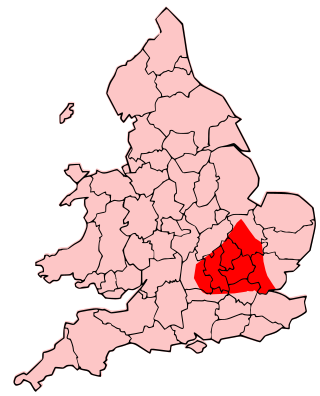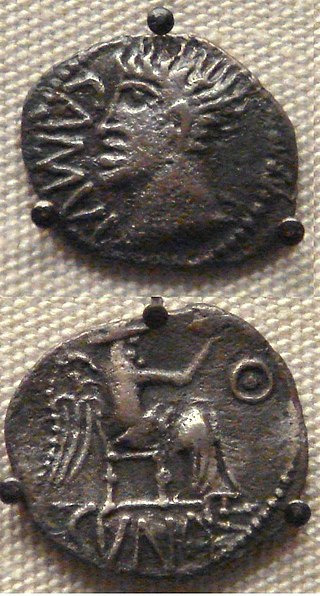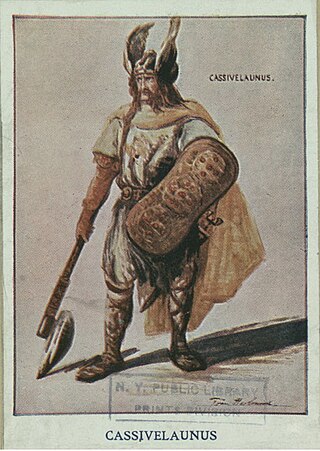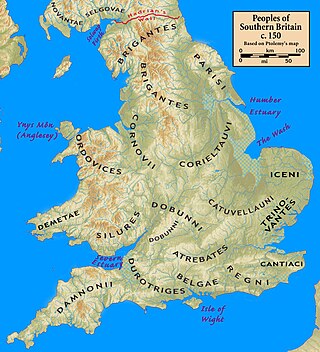
The Trinovantēs or Trinobantes were one of the Celtic tribes of Pre-Roman Britain. Their territory was on the north side of the Thames estuary in current Essex, Hertfordshire and Suffolk, and included lands now located in Greater London. They were bordered to the north by the Iceni, and to the west by the Catuvellauni. Their name possibly derives from the Celtic intensive prefix "tri-" and a second element which was either "nowio" – new, so meaning "very new" in the sense of "newcomers", but possibly with an applied sense of vigor or liveliness ultimately meaning "the very vigorous people". Their capital was Camulodunum, one proposed site of the legendary Camelot.
The Atrebates were a Belgic tribe of the Iron Age and the Roman period, originally dwelling in the Artois region.

The Catuvellauni were a Celtic tribe or state of southeastern Britain before the Roman conquest, attested by inscriptions into the 4th century.

Cunobeline or Cunobelin, also known by his name's Latin form Cunobelinus, was a king in pre-Roman Britain from about AD 9 to about AD 40. He is mentioned in passing by the classical historians Suetonius and Dio Cassius, and many coins bearing his inscription have been found. He controlled a substantial portion of south-eastern Britain, including the territories of the Catuvellauni and the Trinovantes, and is called "King of the Britons" by Suetonius. Cunobeline may have been a client king of Rome, based on the images and legends appearing on his coins. Cunobeline appears in British legend as Cynfelyn (Welsh), Kymbelinus or Cymbeline, as in the play by William Shakespeare.
Togodumnus was king of the British Catuvellauni tribe, whose capital was at St. Albans, at the time of the Roman conquest. He can probably be identified with the legendary British king Guiderius. He is usually thought to have led the fight against the Romans alongside his brother, but to have been killed early in the campaign. However, some authorities now argue that he sided with the Romans and is one and the same person as the client-king Tiberius Claudius Cogidubnus, whose original name may have been Togidubnus or Togodumnus.

Cassivellaunus was a historical British military leader who led the defence against Julius Caesar's second expedition to Britain in 54 BC. He led an alliance of tribes against Roman forces, but eventually surrendered after his location was revealed to Julius Caesar by defeated Britons.

Commius was a king of the Belgic nation of the Atrebates, initially in Gaul, then in Britain, in the 1st century BC.
Adminius, Amminius or Amminus was a son of Cunobelinus, ruler of the Catuvellauni, a tribe of Iron Age Britain. His name can be interpreted as Brittonic *Ad-minios, "he who is very tender".

The Roman client kingdoms in Britain were native tribes which chose to align themselves with the Roman Empire because they saw it as the best option for self-preservation or for protection from other hostile tribes. Alternatively, the Romans created some client kingdoms when they felt influence without direct rule was desirable. Client kingdoms were ruled by client kings. In Latin these kings were referred to as rex sociusque et amicus, which translates to "king, ally, and friend". The type of relationships between client kingdoms and Rome was reliant on the individual circumstances in each kingdom.
Eppillus was the name of a Roman client king of the Atrebates tribe of the British Iron Age. He appears to have ruled part of the territory that had previously been held by Commius, the Gaulish former ally of Julius Caesar who fled to Britain following the uprising of Vercingetorix, or possibly of his son. Eppillus is not mentioned in any historical sources. Coins bearing his name also bear the inscription COMMI.FILI which is generally read as Commios filius indicating at least a claim to be Commius's son.
Segovax was one of the four kings of Kent during Julius Caesar's second expedition to Britain in 54 BC, alongside Cingetorix, Carvilius and Taximagulus. The four were allies of the British leader Cassivellaunus, and attacked the Roman naval camp in an attempt to relieve him when he was besieged by Caesar in his stronghold north of the Thames. However the attack failed and Cassivellaunus was forced to seek terms.
Taximagulus was one of the four kings of Kent during Caesar's second expedition to Britain in 54 BC, alongside Cingetorix, Carvilius and Segovax. The four were allies of the British leader Cassivellaunus, and attacked the Roman naval camp in an attempt to relieve him when he was besieged by Caesar in his stronghold north of the Thames. However the attack failed and Cassivellaunus was forced to seek terms.
Lugotorix was a British chieftain who was captured after a failed attack by the four kings of Kent on Julius Caesar's naval camp in 54 BC. His name may mean "mouse-king".
The Ancalites were a tribe of Iron Age Britain in the first century BCE. They are known only from a brief mention in the writings of Julius Caesar. They may have been one of the four tribes of Kent, represented in Caesar by references to the "four kings of that region" and in the archaeological record by distinct pottery assemblages.
The Segontiaci were a tribe of Iron Age Britain in the first century BCE. They are known only from a brief mention in the writings of Julius Caesar. They may have been one of the four tribes of Kent, represented in Caesar by references to the "four kings of that region" and in the archaeological record by distinct pottery assemblages.

In the course of his Gallic Wars, Julius Caesar invaded Britain twice: in 55 and 54 BC. On the first occasion, Caesar took with him only two legions, and achieved little beyond a landing on the coast of Kent. The second invasion consisted of 800 ships, five legions and 2,000 cavalry. The force was so imposing that the Celtic Britons did not contest Caesar's landing, waiting instead until he began to move inland. Caesar eventually penetrated into Middlesex and crossed the Thames, forcing the British warlord Cassivellaunus to pay tribute to Rome and setting up Mandubracius of the Trinovantes as a client king. The Romans then returned to Gaul without conquering any territory.
Cingetorix was one of the four kings of Kent during Caesar's second expedition to Britain in 54 BC, alongside Segovax, Carvilius and Taximagulus. The four were allies of the British leader Cassivellaunus, and attacked the Roman naval camp in an attempt to relieve him when he was besieged by Caesar in his stronghold north of the Thames. However the attack failed and Cassivellaunus was forced to seek terms.
The Cenimagni were a tribe of Iron Age Britain in the first century BCE. They are known only from a brief mention in the writings of Julius Caesar. It has been suggested that the name is a variant of Iceni with the Latin adjective magni, meaning "great". Others have suggested that they may have been one of the four tribes of Kent, represented in Caesar by references to the "four kings of that region" and in the archaeological record by distinct pottery assemblages.
The Bibroci were a tribe of Iron Age Britain in the first century BCE. They are known only from a brief mention in the writings of Julius Caesar. They may have been one of the four tribes of Kent, represented in Caesar by references to the "four kings of that region" and in the archaeological record by distinct pottery assemblages.
The Cassi were a tribe of Iron Age Britain in the first century BCE. They are known only from a brief mention in the writings of Julius Caesar. They may have been one of the four tribes of Kent, represented in Caesar by references to the "four kings of that region" and in the archaeological record by distinct pottery assemblages.







